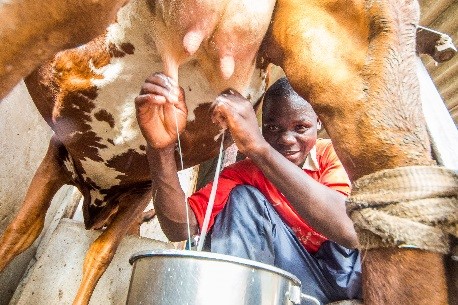Innovative Supplementary Feed Practices Help Farmers in Zimbabwe Cope with Drought
June 8, 2016
Smallholder farmers are often the most vulnerable to climate-related phenomena such as temperature increases, precipitation changes, and extreme weather events. We may not be able to predict exactly which specific geographic areas or crops will be hit the worst by climate change, but we do know that these farmers will likely suffer the most. Therefore, equipping them with the knowledge and skills they need to adapt to and mitigate the effects of climate change is a key focus of Fintrac's work.
Farmers in Zimbabwe have faced a particularly challenging year owing to an El Niño-induced drought that has resulted in massive crop failures and cattle losses. However, many smallholder livestock farmers are unknowingly surrounded by locally-available materials that can be used as alternative feed for livestock.
| |
|
|
|
| |
|
|
 |
| |
|
|
By promoting climate-smart agriculture practices such
as new supplementary feeding practices, Fintrac is
helping livestock farmers in Zimbabwe survive, and
even flourish, during the current drought.
Photo credit: Fintrac Inc. |
Fintrac, through its Feed the Future Zimbabwe Livestock Development Program, is introducing low- to no-cost feed technologies using local resources such as molasses, cacti, and crop residues to bridge this knowledge gap and mitigate the effects of the severe drought. Our technicians work directly with farmers to develop innovative feed formulas that can sustain their cattle during dry periods.
“I lost two cattle to drought due to lack of knowledge last year, but the local bushes are full of cacti,” said farmer Angeline Garwe from southern Manicaland. “I want to have my own cactus garden, and I am also going to utilize cacti from the mountains to feed my six cattle.”
Ledson Mubonesi is another smallholder farmer who joined the program in southern Manicaland and is now producing feed for his seven cattle. Through training and technical support, Mubonesi has established nearly 100 cactus plants and now prepares supplementary feed using cactus, molasses, maize stover, and urea. Each cow requires 5 kilograms of the total mixed ration to maintain body condition in the lean months.
After introducing this new feed formula, Mubonesi has increased his milk yields from 0.5 to 2 liters per cow per day, and one of his cows is now in reasonable condition for rebreeding. Mubonesi is a lead farmer who hosts a center of excellence where good animal husbandry practices taught by program specialists are disseminated to more than 100 surrounding farmers.
Another low-cost intervention Fintrac is promoting in Zimbabwe is urea-treated stover. Urea is a water-soluble compound that can be used to treat crop residue such as maize stover, wheat straw, and tough grasses to improve protein content and digestibility. The process involves mixing chopped crop residue with urea dissolved in water and creating a hermetic seal of the mixture with a layer of plastic and a foot of soil.
To improve the utilization of crop residue in supplementary fodder, Fintrac also helped a group of nine dairy farmers get a loan to purchase a diesel-powered chaff cutter that they are now using to chop abundant stover from a nearby irrigation scheme. The multi-functional cutter enables the farmers to chop maize stover and crush grains for livestock feed, and it grinds maize grain into mealie meal. As a result, the farmers can earn additional income by using this machine to provide these services to other farmers.
Affordability and availability of supplementary feed options that make use of drought-tolerant resources enable farmers to keep their animals in good health during critical periods. Even during lean months, cattle can maintain ideal body condition and increased conception rates when properly supplemented with protein-rich fodder available locally, helping farmers minimize the effects of climate change.
About Fintrac: Fintrac is a woman-owned, US-based consulting company that develops agricultural solutions to end hunger and poverty. For 25 years, we have worked with local and global partners to increase production, improve postharvest handling, add value, and develop markets and competitive value chains for some of the world’s most vulnerable farmers and communities. Since 2000, we have improved the food security of 5 million people, and in 2015 alone, we worked with 860,000 rural households across 16 countries.